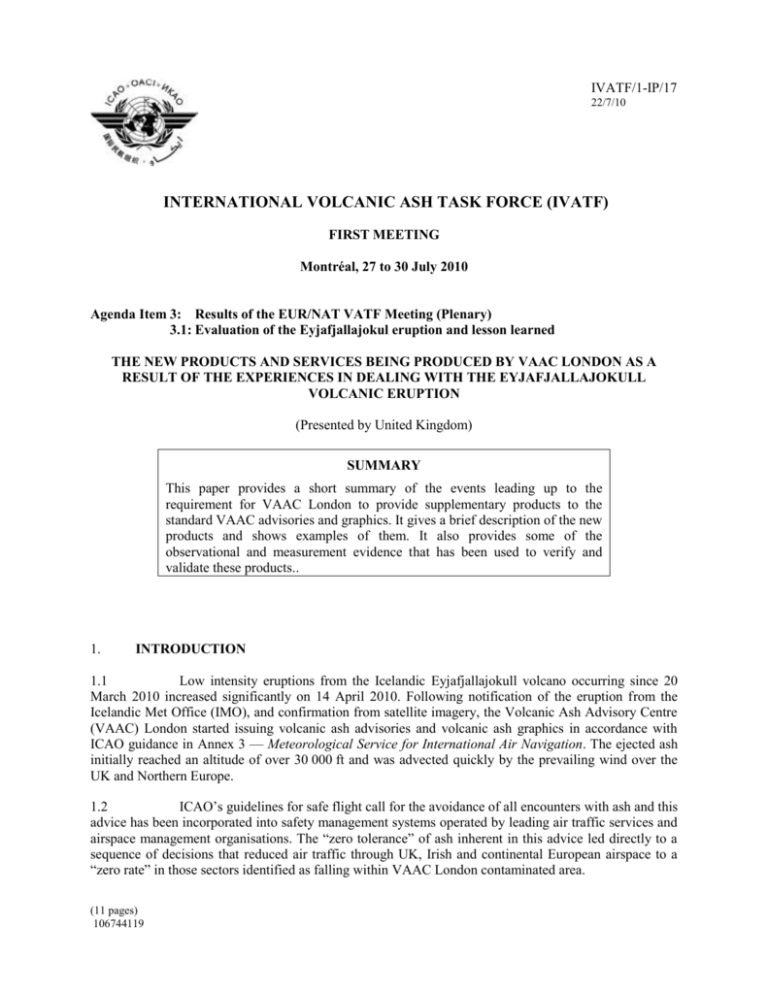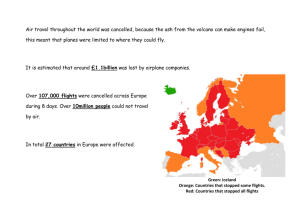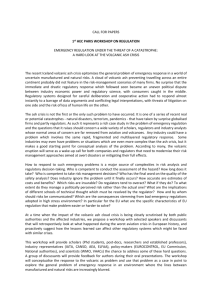IP.17
advertisement

IVATF/1-IP/17 22/7/10 INTERNATIONAL VOLCANIC ASH TASK FORCE (IVATF) FIRST MEETING Montréal, 27 to 30 July 2010 Agenda Item 3: Results of the EUR/NAT VATF Meeting (Plenary) 3.1: Evaluation of the Eyjafjallajokul eruption and lesson learned THE NEW PRODUCTS AND SERVICES BEING PRODUCED BY VAAC LONDON AS A RESULT OF THE EXPERIENCES IN DEALING WITH THE EYJAFJALLAJOKULL VOLCANIC ERUPTION (Presented by United Kingdom) SUMMARY This paper provides a short summary of the events leading up to the requirement for VAAC London to provide supplementary products to the standard VAAC advisories and graphics. It gives a brief description of the new products and shows examples of them. It also provides some of the observational and measurement evidence that has been used to verify and validate these products.. 1. INTRODUCTION 1.1 Low intensity eruptions from the Icelandic Eyjafjallajokull volcano occurring since 20 March 2010 increased significantly on 14 April 2010. Following notification of the eruption from the Icelandic Met Office (IMO), and confirmation from satellite imagery, the Volcanic Ash Advisory Centre (VAAC) London started issuing volcanic ash advisories and volcanic ash graphics in accordance with ICAO guidance in Annex 3 — Meteorological Service for International Air Navigation. The ejected ash initially reached an altitude of over 30 000 ft and was advected quickly by the prevailing wind over the UK and Northern Europe. 1.2 ICAO’s guidelines for safe flight call for the avoidance of all encounters with ash and this advice has been incorporated into safety management systems operated by leading air traffic services and airspace management organisations. The “zero tolerance” of ash inherent in this advice led directly to a sequence of decisions that reduced air traffic through UK, Irish and continental European airspace to a “zero rate” in those sectors identified as falling within VAAC London contaminated area. (11 pages) 106744119 IVATF/1-IP/17 -2- 1.3 VAAC London uses a world leading atmospheric dispersion model, NAME (Numerical Atmospheric-dispersion Modelling Environment), to predict the advection and dispersion of volcanic ash. It is a tried and tested dispersion model, proven during events such as Chernobyl, the Buncefield fire, the outbreak of the animal disease Bluetongue, and many other pollution events including the Grimsvotn volcanic eruption in Iceland in 2004. The latter event was used as a comparison exercise of five of the VAACs dispersion models, the results of which were published in the scientific literature (Witham et al. 2007, Meteorological Applications 14: 27-38 refers). 1.4 There is currently no consistency in the way that VAACs define the ash cloud boundary with thresholds depending variously on the source release rate used, availability of satellite data for comparison and forecaster judgement. VAAC London uses a visual ash cloud look up table to determine hazardous ash concentration as a function of plume height. This table was originally constructed by NOAA for the VAFTAD dispersion model and was based on the correspondence between an ash cloud modelled on a 1 unit source and that seen on satellite imagery for real eruption scenarios. As such it is an empirical relation and as a result, for the Eyjafjallajokull volcano, the boundary of the hazardous ash cloud was set at 1x10-17 units/m3. 1.5 Throughout the whole event, and up to the current time, eruptions from Eyjafjallajokull have been very episodic with higher intensity, explosive events being separated by low intensity emissions. Although the NAME model can handle relatively high frequency variations in the source strength it has been very difficult to get accurate, high frequency observations of the volcano’s intensity to simulate it accurately in the model. Bad weather has affected Iceland on numerous occasions hindering visual observations both from the ground and from the air, and making it very difficult to get reliable radar measurements of the emitted plume top. Therefore, the source strength in the model has only been changed when a relatively high level of confidence can be obtained from Iceland that a change has actually happened. VAAC London would like to thank the efforts that IMO have put in to make observations of the volcano available in a timely manner. 2. DISCUSSION 2.1 Due to the background synoptic situation, following the increased emissions on 14 April 2010, a plume of ash from the volcano was rapidly advected down the North Sea and then dispersed over a very large area of central and northern Europe. Figure 1 shows output from the NAME model on 17 th April and the huge area that was already being affected. Figure 2 shows a Lidar image on the 17 April showing the position of the ash cloud over Zurich providing good verification of the prediction of the model. By 18 April 2010, commercial aviation movement through the airspace of 23 European countries had ceased and restrictions were in place in two other countries. Over 300 airports representing 75 per cent of the European network, closed. In general within a day of the ash being emitted the material had been dispersed enough that it was difficult to detect from satellite imagery and would be getting more and more difficult to see with the naked eye. However, the NAME model, backed up by limited scientific measurements within the UK, was indicating that the ash was remaining in the atmosphere in relatively significant concentrations – certainly high enough for VAAC London to consider that it should continue reporting it following ICAO guidelines that aviation should avoid “any ash”. 2.2 The Met Office, the UK CAA and Department for Transport quickly requested that observations and scientific measurement of the ash cloud from around the UK and across Europe could be sent to the Met Office to help validate the NAME model and provide evidence to the airlines of the potential danger of non-visible ash plumes. VAAC London who has been collating these observations would like to thank the numerous, national met services, academic research organisations, atmospheric -3- IVATF/1-IP/17 research aircraft groups, airlines and military aircraft that provided them. The observation platforms included: a) geostationary and polar orbiting satellites, b) the NERC Dornier aircraft, c) the FAAM BAe 146, d) the DLR Falcon which operated both in Germany and for a time in Iceland, e) numerous LIDARs from around the UK and across Europe, f) aerosol probes mounted on balloons, g) ozone sondes, h) cloud base recorders, i) measurements of direct and diffuse broadband solar radiation, j) visual observations, k) lightning location – indicative of the strength of the volcano, and l) other measurements carried out on behalf of government agencies. 2.3 Eurocontrol has reportedly estimated that more than 100 000 flights were cancelled affecting the travel plans of around 10 million passengers. The airlines estimate their losses in the order of Euro 1.4 billion, the airports Euro 250 million, ground handlers Euro 200 million and air navigation service providers Euro 175 million with wider impacts beyond this grouping. 2.4 Urgent confirmation was needed as to whether a “zero tolerance” of volcanic ash was necessary to maintain flight safety. If not, then there was an urgent need to identify a density of ash which could easily be tolerated by commercial aircraft and engines – a piece of information that the VAACs have been requesting for over a decade. It was acknowledged that even if it could be established that operations in such ash densities were safe, there might be economic penalties in relation to an escalation in the engineering interventions necessary to sustain airworthiness standards. 2.5 On 16 April 2010 the UK CAA hosted the first of a series of teleconference meetings aimed at gathering together the world’s leading aircraft and engine manufacturers to focus on this issue. Supporting these discussions were leading scientific experts in meteorology, geology, and volcanology. Air traffic service experts, airspace managers and leading airlines also supported the work. 2.6 More than 60 organisations participated in a series of six teleconferences between 16 and 23 April 2010. Data was made available to the group from some of the Dornier research aircraft flights through the ash cloud over the UK. On 20 April 2010, the aircraft and engine manufacturers determined that their aircraft and engines would tolerate operations in an ash density of 2x10 -3g/m3 subject to appropriate precautionary maintenance practices being applied and the avoidance of visible ash. Based on IVATF/1-IP/17 -4- this number the UK CAA (UK National Supervisory Authority) instructed VAAC London to provide some supplementary products to the standard VAAC advisories and graphics. These included a: a) series of graphics produced automatically from the NAME model output (assuming a 109g/s release rate from the volcano) for the standard VAAC issuance times and standard layers in the vertical with no human intervention which showed: 1) filled in red contour which showed a 2x10-4g/m3 concentration boundary threshold – this is very similar to the red contour shown on the standard VAAC graphic; 2) filled in black contour which showed a 2x10-3g/m3 concentration boundary threshold; and 3) black dotted line which showed a 60 nm buffer zone around the black contour b) CSV file with the coordinates of the 60 nm buffer zone which the UK CAA is currently using to determine their NOTAM no-fly zones. 2.7 Figure 3 shows examples of these charts for 1200z on 6 May 2010. Figures 4 and 5 show the processed satellite imagery and visible imagery of the ash cloud at the times of the predictions shown on the supplementary VAAC charts. 2.8 As mentioned in 2.2 the Met Office throughout this event has been collating volcanic ash plume observations and measurements in order to verify the NAME model and provide evidence of the presence of ash to the aviation community. Although the observations are relatively limited in terms of geographical spread there are now a significant number of them. A Met Office document produced in conjunction with the National Centre for Atmospheric Science and the University of Reading called “Eyjafjallajokull Volcano Dust Plume – A Summary of Met Office Monitoring and Prediction Capability” has been put together. It was felt that for the purposes of this paper it would be useful if the meeting could see a couple of examples of the sorts of observations that are being recorded and how they compare with the predictions of the NAME model and verify and validate them. 2.9 Figure 6 shows a picture from the downward facing Lidar on the BAe 146 research aircraft flying between Edinburgh and Glasgow in Southern Scotland on 5 May 2010. Figure 7 shows the supplementary VAAC chart at a similar time to when the observation was being made. A low level ash plume between 8 000ft and 10 000ft is being observed and this agrees well with the area of the red zone shown on the VAAC supplementary chart covering much of Scotland. 2.10 Figure 8 shows another example for the 4 May 2010. This time an observation from a ground based vertically pointing Lidar at Aberystwyth on the west coast of Wales is shown. A low level ash cloud between 1km and 4 km in the vertical is seen and the measurements represent about 5x10 -4g/m3 of ash in the plume. Once again this agrees well with the model prediction which shows the edge of the red zone over the coast of Wales. 2.11 The Eyjafjallajokull volcano eruption event is perhaps the first time that a sophisticated, tried and tested, dispersion model has been used to predict the full extent of what are at times, relatively low concentrations of volcanic ash over large areas of high capacity airspace for an extended period of time. The experiences of VAAC London and the European aviation community during this period have shown that the ICAO guidelines that aircraft should avoid “all” encounters with volcanic ash is very -5- IVATF/1-IP/17 conservative and that there is no globally recognised safe threshold for ash concentration levels to fly in is unacceptable. The UK CAA has now managed to get the engine manufacturers to provide their first estimates of a safe ash concentration threshold, which have been used to produce new supplementary VAAC products for the European region. These should be used by ICAO to form the basis for developing new advisory products for issuance by VAACs globally. 3. 3.1 ACTION BY THE IVATF The IVATF is invited to note the contents of this paper. ———————— IVATF/1-IP/17 -6- Figure 1: Output from the NAME model showing that after 2 days following the eruption the ash cloud had been dispersed to cover much of Europe. -7- IVATF/1-IP/17 Figure 2: An aerosol lidar measurement from Zurich. The ash plume is depicted by the light blue and yellow band that descends from 7,000m at 1900 on 16th April 2010 to 3,000m at 0935 on 17th April 2010. Some of these measurements coincide with the forecast of the plume dispersion shown in Figure 1. IVATF/1-IP/17 -8- Figure 3: Examples of the new VAAC London product depicting the standard volcanic ash graphic (red shaded area), the new higher density (>2x10-3g/m3) ash cloud (black shaded area), and the 60nm buffer zone (dotted line) around the black zone) for 0 to 20,000ft (top graphic) and 20,000ft to 35,000ft (lower graphic). -9- IVATF/1-IP/17 Figure 4: An example of a processed satellite picture showing the plume of volcanic ash on 6 May 2010 which corresponds to the same time the VAAC graphics in figure 1 were produced. Figure 5: An example of a visible satellite image of the plume of volcanic ash on 6th May 2010 which corresponds to the same time the VAAC graphics in figure 1 were produced. IVATF/1-IP/17 - 10 - Figure 6: Picture from a downward facing Lidar on the BAe 146 research aircraft flying at 20,000ft between Edinburgh (left hand side of picture) and Glasgow (right hand side of picture) on 5th May 2010. The red and yellow layer between 8,000 and 10,000ft is an extensive plume of volcanic ash across southern Scotland. The red layer at 20,000ft is cirrus cloud which partially attenuates the lidar signal and the red layer at 6,000ft is boundary layer cloud Figure 7: New London VAAC product for the same time as the BAe 146 research aircraft was flying between Edinburgh and Glasgow on 5th May 2010 making the Lidar measurements shown in figure 4. This provides good verification of the NAME model at this time. - 11 - IVATF/1-IP/17 Figure 8: Output from the Raman Lidar at Aberystwyth on 4th May 2010 showing a plume of volcanic ash between 1km and 4km altitude. Figure 9: New London VAAC product for a similar time as the Aberystwyth Raman Lidar measurements on 4 May 2010 shown in figure 6. This provides good verification of the NAME model at this time. — END —








